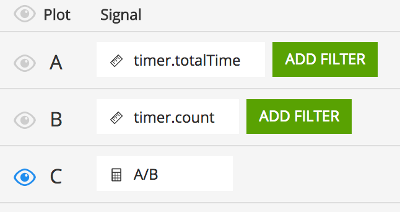|
For the latest stable version, please use Micrometer 1.16.1! |
Micrometer SignalFx
SignalFx is a dimensional monitoring system SaaS with a full UI that operates on a push model. It has a rich set of alert “detectors”.
1. Installing
For Gradle, add the following implementation:
implementation 'io.micrometer:micrometer-registry-signalfx:latest.release'For Maven, add the following dependency:
<dependency>
<groupId>io.micrometer</groupId>
<artifactId>micrometer-registry-signalfx</artifactId>
<version>${micrometer.version}</version>
</dependency>2. Configuring
The following example configures SignalFx:
SignalFxConfig signalFxConfig = new SignalFxConfig() {
@Override
public String accessToken() {
return "MYTOKEN";
}
@Override
public String get(String k) {
return null; // accept the rest of the defaults
}
};
MeterRegistry registry = new SignalFxMeterRegistry(signalFxConfig, Clock.SYSTEM);There are two distinct sources of API keys in SignalFx.
SignalFxConfig is an interface with a set of default methods. If, in the implementation of get(String k), rather than returning null, you instead bind it to a property source, you can override the default configuration. For example, Micrometer’s Spring Boot support binds properties that are prefixed with management.metrics.export.signalfx directly to the SignalFxConfig:
management.metrics.export.signalfx:
access-token: MYTOKEN
# The interval at which metrics are sent to Ganglia. See Duration.parse for the expected format.
# The default is 1 minute.
step: 1m3. Graphing
This section serves as a quick start to rendering useful representations in SignalFx for metrics originating in Micrometer. See the SignalFx docs for a far more complete reference of what is possible in SignalFx.
3.1. Timers
At each publishing interval, the SignalFx Timer produces several time series in SignalFx:
-
${name}.avg: A mean latency for the publishing interval. -
${name}.count: Throughput per second over the publishing interval. -
${name}.totalTime: Total time per second over the publishing interval (used withcount) to create aggregable means. -
${name}.percentiles: Micrometer calculated percentiles for the publishing interval. One time series is produced for each percentile, with a tag ofphiin the range of [0,1]. -
${name}.histogram: One event is produced for each SLO boundary with a tag of 'le', indicating that it represents a cumulative count of events less than or equal to SLO boundaries over the publishing interval.
To generate an aggregable view of latency in SignalFx, divide totalTime by count:

This is accomplished by adding signals for ${name}.totalTime and ${name}.count, adding a formula that divides them, and hiding the inputs to the formula.

To generate a throughput chart, use the ${name}.count signal:

To generate a plot of client-side percentiles, use the ${name}.percentiles signal:

Note that these percentiles are not aggregable. The more dimensions you add to a timer, the less useful these values become.
Finally, if you define SLO boundaries with the fluent builder for Timer, you can view throughput below certain SLO boundaries by using the ${name}.histogram signal. In this example, we set SLO boundaries at 275 (green), 300 (blue), and 500 (purple) milliseconds for a simulated Timer that is recording samples normally distributed around 250 ms. These counts represent the rate/second of samples less than or equal to each SLO boundary.

Where the lines converge at various points, it is evident that no sample exceeded the 275 ms SLO boundary.

